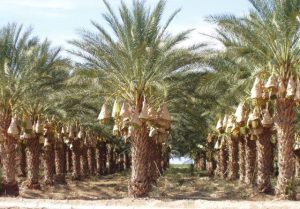
By Rebecca Plevin
As workers harvest dates across the Coachella Valley, growers and researchers are undertaking another huge task: Preventing a two-inch, invasive pest from boring into the palm trees that bear the sticky, sweet fruit.
The pest, the invasive South American palm weevil, feasts on date palms, fan palms and other types of palm trees. In 2011, it spread from Mexico to San Diego County, where it’s now killing Canary Island date palm trees.
“Right now, it’s not in our area,” said Albert Keck, president of Hadley Date Gardens in Thermal and chairman of the California Date Commission. “We’re not in a panic mode right now. We’re in a very precautionary mode.”
Keck is working with scientists from University of California, Riverside and Riverside biotech company ISCA Technologies to develop ways to prevent the pests from taking a bite out of the Coachella Valley’s date industry, which supplies about 95 percent of the country’s dates.
The date industry, which employs several thousand people, last year produced more than 31,000 tons of dates and generated more than $46 million in sales, according to the U.S. Department of Agriculture.
But the South American palm weevil could wreak havoc on the date industry. The pests bore holes in the leaf bases in the crowns of palm trees. Females lay their eggs in these holes and seal them off with wax. The larvae then eat the palms from the inside out, typically in the crown of the tree.
An infestation can damage the crown of the tree; if it gets bad enough, it can cause the tops of trees to droop and collapse.
Research on the pest is supported by a $300,000 grant that was announced last week. The non-profit Foundation for Food and Agriculture Research contributed $150,000, with other organizations, including UC Riverside, ISCA Technologies and the California Date Commission, matching that.
“If you can keep the population down to a minimum, you can keep the devastation down,” said Sally Rockey, executive director of the research foundation.
As part of the prevention campaign, UC Riverside and ISCA Technologies have developed a chemical formula that attracts palm weevils.
They plan to set up about 100 bucket-shaped traps throughout the valley by the spring, said Dr. Mark Hoddle, director of UC Riverside’s Center for Invasive Species Research. The traps feature the formula that attracts weevils; the pests fly into the buckets and then drown in a preservative, he said.
The traps will allow scientists to monitor the presence of weevils in the region. They can also help contain infestations and prevent the pests from spreading to rural areas where dates grow, he said.
As a second strategy, researchers will put the formula into small dollops of wax, which contain small but lethal doses of a pesticide. The wax will then be applied in silver dollar-sized dollops to trees, allowing researchers to kill the weevils without spraying pesticides on entire trees, Hoddle said.
“The weevil is going to probably arrive at some stage, so we need to be prepared for that eventuality,” Hoddle said.
Hadley Date Gardens specializes in Deglet Noor and Medjool varieties of dates, according to Keck, the third-generation owner of the company. He will likely have some of the scientists’ traps in his orchards, which stretch across the valley to the Salton Sea. He’s willing to support the research, he said, if the tools stop the infestation from spreading from San Diego to the valley.
“We just do not want it to get out from that area right now,” he said. “We want to contain it and eradicate it there if possible.”


